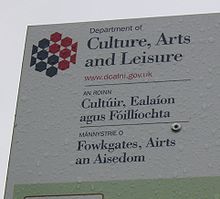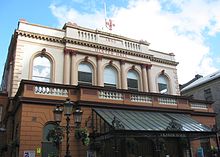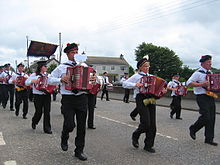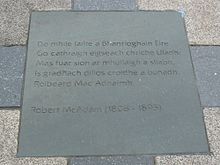- Culture of Northern Ireland
-
The culture of Northern Ireland relates to the traditions of Northern Ireland and its resident communities.
Elements of the culture of Ireland, the culture of Ulster and the culture of the United Kingdom are to be found.
Contents
Heritage
Since 1998 the Ulster Museum, Armagh Museum, Ulster Folk and Transport Museum and the Ulster American Folk Park have been administered by the (National Museums and Galleries of Northern Ireland).
The Linen Hall Library, the oldest library in Belfast, has endured many changes of fortune since its foundation in 1788, but has maintained a vision of providing access to literature and local studies to the population at large.
- Abbeys and priories in Northern Ireland
- Gardens in Northern Ireland
- Giant's Causeway
- Historic houses in Northern Ireland
- Museums in Northern Ireland
- National parks of Northern Ireland
Food and drink
The best known traditional dish in Northern Ireland is the Ulster fry.[citation needed] It is similar to the full Irish breakfast and full English breakfast, but with the unique addition of soda farls and potato bread. Northern Ireland's best known chefs are Paul Rankin and Michael Deane.[citation needed] The 'Ulster Fry' is served in many places in County Donegal as well.
Languages
 The brand identity of the Department of Culture, Arts and Leisure in Northern Ireland as shown on this sign is displayed in English, Irish and Ulster Scots
The brand identity of the Department of Culture, Arts and Leisure in Northern Ireland as shown on this sign is displayed in English, Irish and Ulster Scots
English is the most spoken language in Northern Ireland. There are also two recognised regional languages in Northern Ireland: the Irish language (see Irish language in Northern Ireland) and the local variety of Scots known as Ulster Scots.[1] Northern Ireland Sign Language (known as British Sign Language to many) and Irish Sign Language have been recognised since 29 March 2004.[2][3]
As of the 2001 Census, Chinese is the most widely spoken minority language in Northern Ireland, with Shelta, Arabic and Portuguese also spoken by a significant number of people.[1] Since the census however, an influx of people from recent EU accession states is likely to have significantly increased numbers of speakers of languages from these countries. Detailed figures on these changes are as yet unavailable.[1]
Sport
Some team sports are played on an all-Ireland basis, while in others Northern Ireland fields its own team. See Sport in Ireland
- Belfast Giants
- 'Football special'
- Gaelic football
- Hurling
- Gaelic handball
- Milk Cup International youth association football competition held in Northern Ireland
- Northern Ireland national football team
- Royal Portrush Golf Club
- Ulster GAA
- Ulster Rugby
Internationally well-known sports people:[citation needed]
- George Best - footballer, born in Belfast
- Darren Clarke - golfer, born Dungannon
- Joey Dunlop
- Dave Finlay
- Alex Higgins
- David Humphreys
- Eddie Irvine
- Dave McAuley
- Willie John McBride
- Tony McCoy
- Wayne McCullough
- Mary Peters
- Ronan Rafferty
- Dennis Taylor
- Andrew Trimble
- Norman Whiteside
- Cormac McAnallen
- Rory McIlroy
Arts
Literature
Despite its small geographical size, Northern Ireland prolifically produces internationally renowned writers and poets from a wide variety of disciplines.[citation needed] Irish language literature was the predominant literature in the pre-Plantation period. The Ulster Cycle is pertinent to the history of literature in the territory of present-day Northern Ireland. Ulster Scots literature first followed models from Scotland, with the rhyming weavers, such as James Orr, developing an indigenous tradition of vernacular literature. Writers in the counties which now form Northern Ireland participated in the Gaelic Revival.
- John Brown
- Ciarán Carson
- Mairtín Crawford
- Brian Friel
- Seamus Heaney
- John Hewitt
- C. S. Lewis
- Bernard MacLaverty
- Louis MacNeice
- Ian McDonald
- Medbh McGuckian
- Gerard McKeown
- Paul Muldoon
- Flann O'Brien
- Frank Ormsby
- Tom Paulin
- Richard Rowley
- Bob Shaw
- David Park
Visual arts
For a full list, see List of Northern Irish artists. Here are just a few examples:
- Bogside Artists
- Basil Blackshaw, born in Glengormley, Painter
- Max Clendinning, post-modernist architect and interior designer
- John T. Davis, Documentary filmmaker
- Willie Doherty, Photographer & video artist twice nominated for the Turner Prize
- John Duncan, Photographer & editor of Source Magazine
- Garth Ennis, born in Holywood Co. Down, is creator of popular Vertigo series Preacher
- Terry George, born in Co. Down, director of Hotel Rwanda
- Dave McElfatrick, co-creator of popular comic franchise Cyanide & Happiness
- John Kindness, Painter and Sculptor
- Sir John Lavery, born in Belfast, was a representative of the group known as the Irish Impressionists.
- Eilís O'Connell, Sculptor, born in Derry, County Londonderry.
- Peter Richards, Photographer & video artist.
- Neil Shawcross, painter
- Paul Seawright, Photographer & Professor at the University of Ulster
- Victor Sloan, Photographer
- Hans Sloane, Born in Killyleagh, Co. Down, in 1660, his famous collection was opened to the public as the British Museum in 1759
- John Butler Yeats, Painter
Performing arts
 Ulster Hall, Belfast, is a venue for concerts and performance.
Ulster Hall, Belfast, is a venue for concerts and performance.
- Kenneth Branagh
- Brian Friel
- Ciarán Hinds
- Mickey Marley
- Siobhán McKenna
- Liam Neeson
- Sam Neill
- James Nesbitt
- Stephen Rea
- Ray Stevenson
Music
- Brian Kennedy
- Derek Bell
- Duke Special
- The Freshmen
- Gary Moore
- James Galway
- General Fiasco
- Tony McAuley
- Neil Hannon
- Ruby Murray
- Snow Patrol
- Stiff Little Fingers
- Two Door Cinema Club
- The Undertones
- Therapy?
- Ulster Orchestra
- Hamilton Harty
- Michael Alcorn
- The Answer
- Van Morrison and Them
- David McWilliams
- Foy Vance
- In Case of Fire
Craft
August Craft Month is an annual coordinated programme of events that showcase the work of craft makers in Northern Ireland and from across the United Kingdom, Ireland and Europe.It is organised by Craft Northern Ireland [4]
Songs
Among traditional songs are The Sash and A Londonderry Air also known as Danny Boy.[citation needed]
Symbolism and traditions
There is no longer an official Flag of Northern Ireland, as the 'Northern Ireland Flag' was abolished along with the Parliament of Northern Ireland in 1972. Unionists tend to use the Union Flag and sometimes the Ulster Banner, while nationalists usually use the Flag of Ireland, or sometimes the Flag of Ulster. Both sides also occasionally use the flags of secular and religious organizations they belong to. Some groups, including the Irish Rugby Football Union and the Church of Ireland use the Flag of St. Patrick as a symbol of Ireland which lacks the same nationalist or unionist connotations.
The flax flower, representing the linen industry, has been used as a neutral symbol - as for the Northern Ireland Assembly.
St. Patrick's Day is celebrated by both nationalists and unionists, while "The Twelfth" is celebrated only by unionists.
 Apprentice Boys band marching in Bushmills
Apprentice Boys band marching in Bushmills
Celebrations to mark the anniversary of the Battle of the Boyne are held every Twelfth of July and draw huge crowds. The Apprentice Boys of Derry also organise commemorative events. The bowler hat is a symbol of Orangeism.
See also
- Culture of Belfast
- Lyric Theatre (Belfast)
- Belfast Festival at Queens
- Belfast Film Festival
- CineMagic (film festival)
- Irish art
- Irish literature
- Irish music
- Odyssey
- Queen's Film Theatre
- Strand Cinema
- Ulster Scots
- Waterfront Hall
- Tennents ViTal
- Audiences NI
References
- ^ a b c "Language/Cultural Diversity: Frequently Asked Questions". Department of Culture, Arts and Leisure. http://www.dcalni.gov.uk/index/language-cultural-diversity-r08/frequently_asked_questions.htm. Retrieved 2011-01-31.
- ^ "Sign Language". Department of Culture, Arts and Leisure. http://www.dcalni.gov.uk/index/languages/sign_language.htm. Retrieved 2011-01-31.
- ^ "Paul Murphy announces recognition for sign language". Northern Ireland Office. 2004-03-30. http://www.nio.gov.uk/paul-murphy-announces-recognition-for-sign-language/media-detail.htm?newsID=8540. Retrieved 2011-01-31. "I am pleased to announce formal recognition for both British and Irish Sign Languages in Northern Ireland."
- ^ http://www.craftni.org
External links
- Culture Northern Ireland
- The Lyric Theatre
- The Lyric Theatre Fundraising Campaign
- National Museums and Galleries of Northern Ireland
- Department of Culture, Arts and Leisure (DCAL)
- Arts Council of Northern Ireland
- Poetry Forum for Northern Ireland,
- 2007 Smithsonian Folklife Festival
- Audiences NI
- Scoil Cheoil na Botha- music festival in the border region of Scotstown, Co. Monaghan
Culture of Europe Sovereign
states- Albania
- Andorra
- Armenia
- Austria
- Azerbaijan
- Belarus
- Belgium
- Bosnia and Herzegovina
- Bulgaria
- Croatia
- Cyprus
- Czech Republic
- Denmark
- Estonia
- Finland
- France
- Georgia
- Germany
- Greece
- Hungary
- Iceland
- Ireland
- Italy
- Kazakhstan
- Latvia
- Liechtenstein
- Lithuania
- Luxembourg
- Macedonia
- Malta
- Moldova
- Monaco
- Montenegro
- Netherlands
- Norway
- Poland
- Portugal
- Romania
- Russia
- San Marino
- Serbia
- Slovakia
- Slovenia
- Spain
- Sweden
- Switzerland
- Turkey
- Ukraine
- United Kingdom
- (England
- Northern Ireland
- Scotland
- Wales)
- Vatican City
States with limited
recognition- Abkhazia
- Kosovo
- Nagorno-Karabakh
- Northern Cyprus
- South Ossetia
- Transnistria
Dependencies
and other territories- Åland
- Faroe Islands
- Gibraltar
- Guernsey
- Jan Mayen
- Jersey
- Isle of Man
- Svalbard
Other entities - European Union
 United Kingdom topics
United Kingdom topicsGeography Administrative Physical Lakes and lochs · Mountains · Rivers · Volcanoes · Great Britain · Geology of Great Britain · Geology of Northern Ireland
History Maritime · Economic · Military · British Empire · Timeline
Politics · Government Economy Pound sterling · London Stock Exchange · Banks (Bank of England) · Taxation · Transport · Communications · Economic geography · Mining · Energy · Budget
Military Society · Demography Cities · Crime · Ethnic groups · Immigration · Languages · Poverty · Social structure · Towns
Culture Art · Cinema · Cuisine · Identity · Literature · Media · Music · Sport · Television · Theatre · Public holidays
England Northern Ireland Scotland Wales History · Welsh Government · Welsh Assembly · First Minister · Politics · Education · Health care · Religion · Tourism
Celtic nations and their cultures Nations Languages Peoples Culture Music Sport Bando · Cammag · Cnapan · Cornish hurling · Cornish wrestling · Curling · Gaelic football · Gaelic handball · Golf · Gouren · Rounders · Highland games · Hurling · Road bowls · ShintyCategories:
Wikimedia Foundation. 2010.



